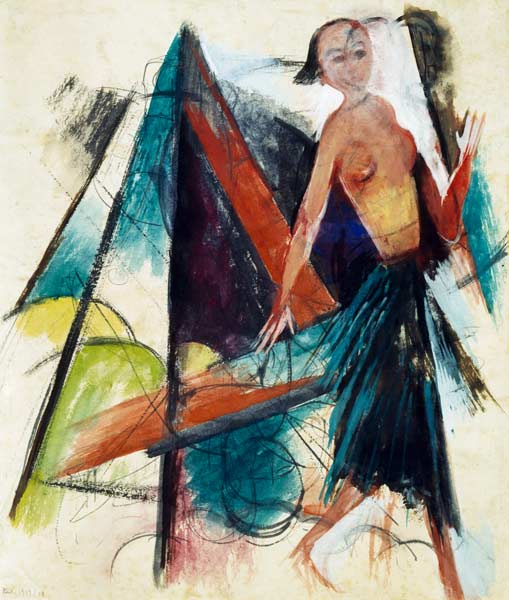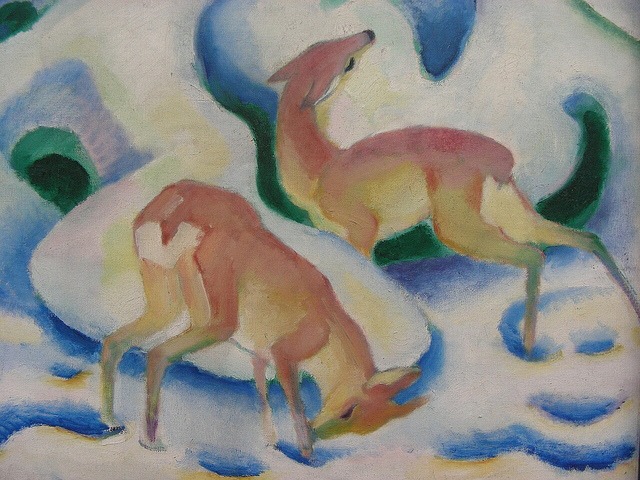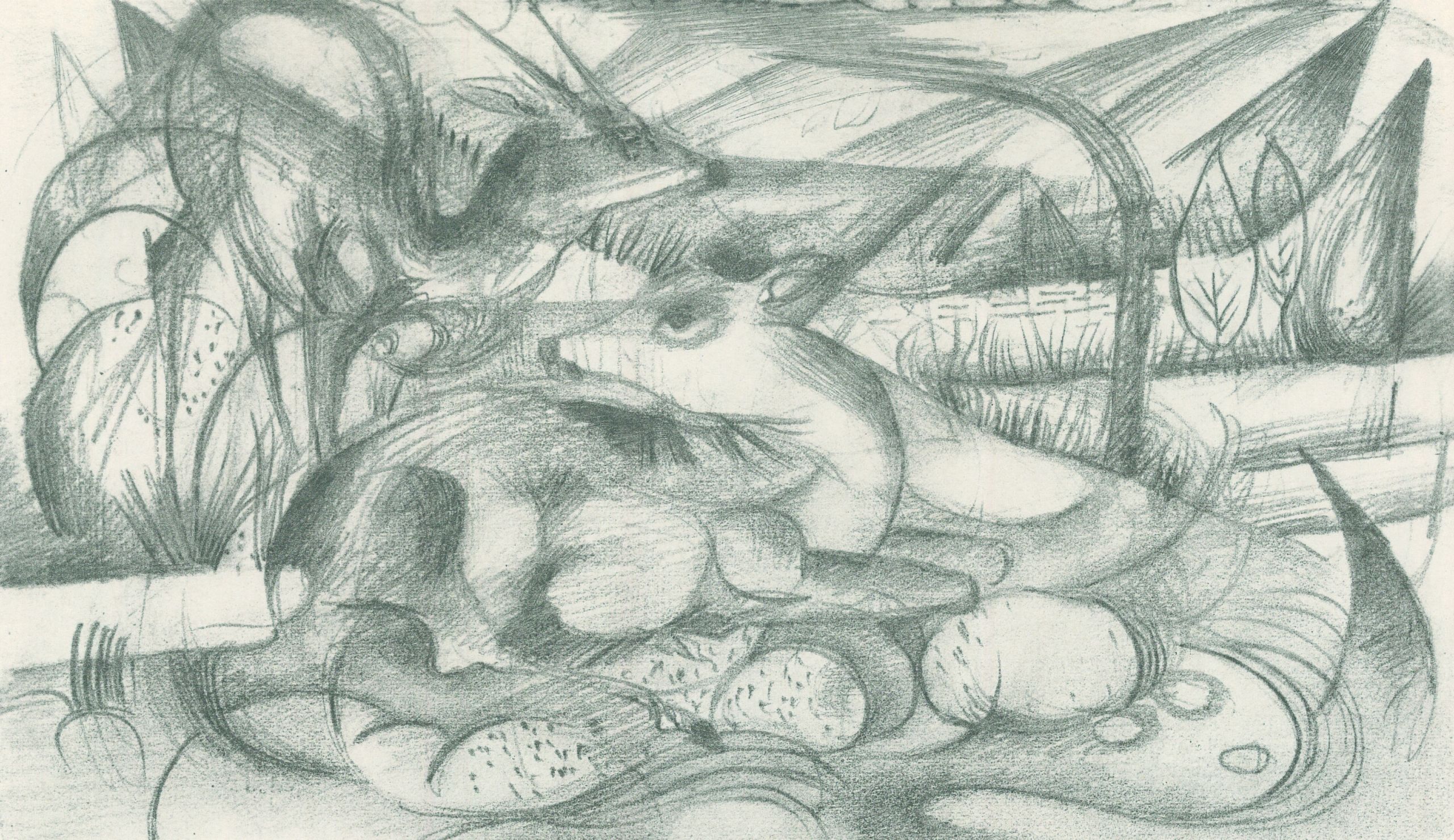
by Jean Marie Carey | 3 Mar 2016 | Animals, Animals in Art, Art History, Expressionismus, Franz Marc, German Expressionism / Modernism

Franz Marc’s palette, from the archives of the Franz Marc Museum, Kochel.
Franz Marc’s “Aphorism 82,” from Die 100 Aphorismen, 1915.
“Ich sah das Bild, das in den Augen des Teichhuhns sich bricht, wenn es untertaucht: die tausend Ringe, die jedes kleine Leben einfassen, das Blau der flüsternden Himmel, das der See trinkt, das verzückte Auftauchen an einem andern Ort, – erkennt, meine Freunde, was Bilder sind: das Auftauchen an einem anderen Ort.”
“I saw what the moorhen sees as it dives: the thousand rings that encircle each little life, the blue of the whispering sky swallowed by the lake, the enraptured moment of surfacing in another place. Know, my friends, what images are: the experience of surfacing in another place.”

by Jean Marie Carey | 11 Jan 2016 | Animals, Animals in Art, Art History, Dogs!, Expressionismus, Franz Marc, German Expressionism / Modernism
In the spirit of rebirth an excerpt from my research about Franz Marc’s visualization of a kind of pantheistic utopia, followed by an introduction and explanation about this new website and some other breaking German Modernism news.
§ § §
Though it doesn’t seem as if these two images appended here could possibly be related, they do have a commonality – the figures are in a state of private reverie that is between sleep and wakefulness.

Franz Marc, Der Traum, 1912.
Franz Marc himself charaterized his mode of trying to perceive as the animal as if in a state of somnambulism, partly conscious yet also given over to the transformative experience of being another, in this dream-like state. The animals to Marc possessed in their purity a sort of natural extraconsciousness. His work has numerous examples of figures in such a “sleepwalking” state, corresponding to the posture of animals, and also people, in a relaxed posture reclining into a receptive earth. This natural somnambulism blurred what was conventionally taken to be a distinction between people and animals, that animals are innate and instinctive, whereas humans can return to this state only in dreams.
In 1911, Marc had written an interesting personal aside in his journal:
[Können wir uns ein Bild machen, wie wohl Tiere uns und die Natur sehen?]
Gibt es für Künstler eine geheimnisvollere Idee als die [Vorstellung], wie sich wohl die Natur in dem Auge eines Tieres spiegelt? Wie sieht ein Pferd die Welt oder ein Adler, ein Reh oder ein Hund? Wie armselig, [ja] seelenlos ist unsre [Gewohnheit] Konvention, Tiere in eine Landschaft zu setzen, die unsren Augen zugehört statt uns in die Seele des Tieres zu versenken, [daß wir das seinen Blick Weltbild] um dessen Bilderkreis zu erraten.
[Diese Betrachtung soll keine müßige causerie sein, sondern uns zu den Quellen der Kunst führen.]1
We can see this interest in the perception of animals reflected not just in Marc’s belief in the inherent Beseeltheit [2] of animals but also in his knowledge of contemporary zoology research taking place at the end of the 19th and beginning of the 20th centuries, for example, the writings of Wilhelm Bölsche on plant and animal taxonomy[3] and more clinical examinations, such as studies about how the retinae of insects’ eyes functioned.[4]
Thus what we think of now as “the question of the animal” was under Marc’s consideration in suprisingly contemporary terms, and should not be considered merely an outflow of his private, sentimental feelings about his pets. Like Kandinsky, Marc was curious as to whether there was a tangible basis for their claims that there existed unseen dimension in the regular order of the world but which had become invisible to callous, spiritually deprived humans.
The sketch, Liegender Hund (Russi), (and note also the title) shows that even before he began to wrangle with the problem of color, Marc was busy practicing making copies and models for his later paintings, sketches which nonetheless stood as discrete works for Marc, since, in his somewhat haphazard fashion, he also named and numbered them.
Unlike Paul Gauguin, from whom he certainly drew upon for ideas about content and color, to Marc, nude women in a natural setting were not excuses for a prurient gaze but rather these women, like Marc’s contemplative animals, symbolized innocence and purity, and were associated with the reclamation of paradise. Dreaming animals and people stood for a somnambulant state marking a kind of emotional perception that synaesthetically included auratic impressions and warmth.[5] In his painting Der Traum in which a “Wilden” woman sits cross-legged. Marc blends this image of longing for an original paradise with the European idea of paradise, where the wild lion, like that of St. Jerome, lives in peaceful harmony with horses and humans. Marc’s Animalisierung is in evidence here. Like “wild” people, animals as envisaged by Marc display a natural attunement to the spheres, having been born directly into their instincts, which modern humans – expelled from paradise – have lost.
(more…)

by Jean Marie Carey | 24 Nov 2015 | Art History, Expressionismus, Franz Marc, German Expressionism / Modernism, Re-Enactments© and MashUps

Miranda, 1914
So I am pleased and grateful to report the publication of my first peer-reviewed anthology chapter in the journal Expressionismus in the special issue Der performative Expressionismus. The article is called “‘Der Sturm’ und die Wilden.? Franz Marcs Entscheidungskampf mit der Theatralität,” which translates imperfectly to something like “‘The Tempest’ and the Savages: Franz Marc’s Decisive Encounter with Theatricality.” (Entscheidungskampf can also mean something like Armageddon/scorched earth, which in this case is accurate.)
The article is currently behind the Neofelis Verlag paywall (for a very reasonable €13), but you will soon find it on JSTOR and elsewhere. If you have any questions about how to view article please email me.
This side project to my main research corrects some chronological errors that have consistently been repeated in both Expressionist and Dada literature about the collaboration of Franz Marc and Hugo Ball on a planned production of The Tempest at the Münchner Kammerspiele. Because the story takes place in early 1914, it has been tempting for scholars – some of them quite formidable – to conclude that it was the war that usurped these plans. However, that is not at all the case.
“What really happened” is of course quite interesting on its face and as a reminder that we in fact know very little in the way of actual facts about the historical avant-gardes, who are fast disappearing into hagiography.
More interesting to me, in terms of writing and research, was the analysis of the two small drawings Marc made as character studies of The Tempest’s Miranda and Caliban personalities. This is the first time these drawings, housed in the Kunsthalle Basel, have been subjected to such scholarly scrutiny and each contains many clues and psychological implications.
I was also intrigued to discover that Marc had sent a draft of his June 1914 essay »Das abstrakte Theater,« (also analyzed in the article) about his frustrating foray into the theater to August Macke, and that the two had previously had many exchanges about the performing arts. In fact it is clear that the very precocious Macke – who at only 21 had been the chief set designer for the theater in Düsseldorf – had had a great influence on Marc’s ideas on the subject – ideas being the key word, since Marc had no firsthand dramaturgical knowledge up until this point.
My colleague here at the university, Prof. Dr. August Obermayer, was the very gracious translator but he also provided invaluable editing and advising, and the Neofelis editors were also a pleasure to learn from.
All in all a great experience and I hope readers will find the unraveling of Expressionist mysteries as fascinating as I do.

Caliban, 1914

by Jean Marie Carey | 29 Aug 2015 | Animals, Franz Marc, German Expressionism / Modernism
My 2012 M.A. thesis, Franz Marc as an Ethologist, is now part of the online collection of the open-access Social Science Research Network (SSRN). You can download it or look at the abstract here.
UPDATE: I just can’t with Elsevier’s involvement with SSRN. In addition to Elsevier being generally evil, not supporting open access, and ruining the Pergamon imprint, more than a year after acquiring SSRN, there is still no discrete art history rubric, or way for authors to track who is looking at their work. But mainly Elsevier is garbage.

Franz Marc, Rehe im Schnee II, 1911, one of Marc’s paintings discussed in my thesis.

by Jean Marie Carey | 7 Jun 2015 | Animals in Art, Art History, Franz Marc

Franz Marc, Skizzenbuch aus dem Felde, Skizze 24, 1915
I recently looked harder at Franz Marc’s experiments with poetry. I think you could say that much of Marc’s writing borrows structurally from poetry, and Marc read a lot of poetry, including all of the classics you’d expect, work by people he actually knew, such as Gottfried Benn and Else Lasker-Schüler. He was also interested in French Symbolist Stéphane Mallarmé, particularly Un coup de dés jamais n’abolira le hasard of 1897, having extensively annotated a copy of the text; contact with Hugo Ball, who was influenced by Mallarmé’s text/design, probably heightened Marc’s attention.
From 1912 Marc made doodles of lines of the following poem here and there, and of course the last line is what Marc had originally intended to be the title of the painting we know as Tierschicksale (1914). But it was not until 1915 he wrote these phrases down all together in his small portfolio of drawings made in Germany and France, during the war. It’s hard to say what the poem means, especially in the context of the (approximately – some leaves may be lost) 35-page sketchbook’s compact animal images, it is very interesting. A translation is elsewhere but here is the original poem:
“…ein rosafarbner Regen viel [sic] / auf grüne Wiesen. / die Luft war wie grünes Glas. / das Mädchen [sah auf’s] blickte ins Wasser; das Wasser war klar [rein] wie Kristall; da weinte das Mädchen. / die Bäume zeigten ihre Ringe; die Tiere ihre Adern”.
(Abgedruckt in: Klaus Lankheit: Franz Marc: sein Leben und seine Kunst. Köln: DuMont 1976, S. 124.)





